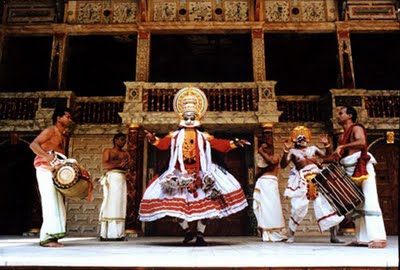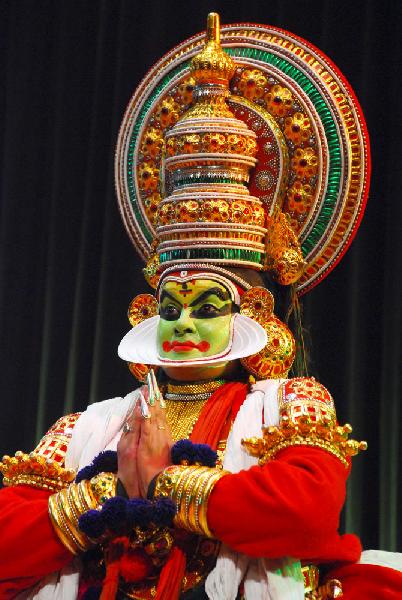Kathakali is an almost equal mixture of dance and drama, the one mingling with the other, literally it means “story play” and represents the masculine and terrifying aspect. Derived from classical dance, it is no more than three hundred and fifty years old in its present form. Its home is located in the south in Kerala, on the opposite side of the country from Bharata Natyam. Its fantastic costumes and make-up, its extraordinary powers of evocation, and its violence all contribute to a dramatic impact that is very far removed from the lyrical elegance of Bharata Natyam.
The great Russian ballet dancer Pavlova once said: “To enter the school of the Imperial Ballet is to enter a convent from which frivolty is banned and where merciless discipline reigns.” She might well have been describing the training of a Kathakali dancer who spends, between childhood and young manhood, long years of training designed to break down the normal coordination of his musculature and so permit a bewildering variety of bizarre postures and movements. It is said with some truth that a Kathakali dancer can make you feel the height and splendor of Mount Kailasa, the legendary abode of Shiva, with but small movements of his eyes.

—It is another form of Indian classical dance where the dancers depict a play, which is generally mythological. Kathakali is famous for its heavy costumes, jewelry and Makeup. It is said that it takes up to 3 – 4 hours for the make up to fix and settle down. The vibrant use of colors in the costume as well as in makeup make to more interesting and full of excitement. Today, Kathakali has become an inseparable part of Kerala’s culture.—click image for source…
Kathakali is always danced at night by the flare of a single oil lamp on a tall stand. The action deals with the more violent passions of gods and demons warring in the Hindu heavens, and it lasts all night.It is allegorical to the extent that characters are identified by their make-up, as good or evil forces similar to Chinese opera. At the end of the night, when the stars are paling in the dawn sky, good eventually triumphs. In the meantime, scenes of murder and drinking of blood, great battles, and the most virulent treachery are enacted to the throbbing drum and the insistent sounds of the music.
The demoniac make-up, the sudden clawing hands and leering faces that appear above a curtain, and the eventual ripping away of the curtain are a mere prelude to the experience of the night’s dancng and dramatics. Absent a knowledge of Hindu mythology and the five hundred mudras or hand gestures the Western spectator, for the most part misses the essence of Kathakali’s meaning but it does not mean we cannot be moved by it since there is probably no performance in the world which so successfully combines visual and itellectual drama in their most violent forms.






 COMMENTS
COMMENTS